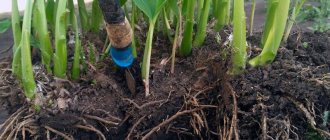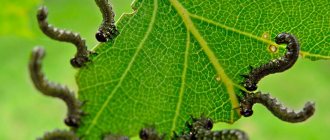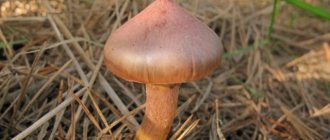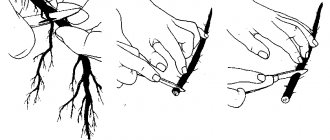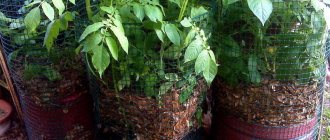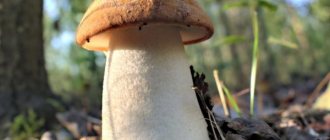Periwinkle (Vinca) is a genus of creeping subshrubs or perennial herbs from the Kutrovaceae family. The culture is growing in many regions of Eurasia and northern Africa. Vinca in translation means “to entwine”, which is associated with the plant’s ability to spread along the ground. Periwinkle is able to survive in harsh conditions. Therefore, it is considered a symbol of vitality. This culture has long been attributed magical properties. If collected at certain times, it can exorcise evil spirits.
Its unpretentiousness and vitality have allowed periwinkle to become very popular for growing in open ground. It grows quickly and reproduces easily. Thanks to the species diversity of periwinkle, you can create original floral compositions in landscape design, combining it with other flowers.
Why do they love him?
Each plant, including the above-mentioned flower, has something to the gardener’s liking. For some, these are gorgeous flowers of incredible beauty, for others - a garden filled with fragrant plants that bloom in the evenings and give off their delightful flair. Why do gardeners resort to improving the area with this plant, wondering how to properly grow periwinkle. Care and planting in open ground is a very controversial issue.
No, it does not have the most luxurious inflorescences (although it is quite pretty), and its aroma will not turn your head. But many people cannot imagine a cozy place in their garden without a specimen of this plant. There are still many gardeners who believe that periwinkle flowers have magical powers and drive away the evil eye from the inhabitants of the home in whose flowerbed a periwinkle bush grows. Periwinkle, which has its own nuances when planted and cared for outdoors in cooler parts of the world, is liked for its delicate beauty of flowers and evergreen leaves.
Varieties of periwinkle
The plant has several types.
Large periwinkle (official name – Vinca major)
It is more of a shrub, has a thin bare stem up to 45 cm high. It has bright blue flowers with slightly narrowed ovoid petals. Grows in Eurasia, North Africa. Rarely found in forests. It grows more in parks and gardens. It begins to bloom in March and continues until April (once a year).
It is practically not used in medicine. It is mainly an aesthetic decoration for city flower beds and garden plots.
Lesser periwinkle (Vinca minor)
Unlike the first type, it is a low-growing shrub creeping along the ground. The length of the stems can be up to 1.5 meters, but they are vegetative and rooting. The plant prefers open, sunny areas. Grows on hillsides and forest edges. Found in Europe and Asia. Herbaceous periwinkle has large flowers with even petals.
When the plant fades, fruits appear in the leaves. It is a pointed oblong capsule filled with brown seeds. In the European part of Russia, periwinkle ripens closer to August-September, and begins to bloom in May-June.
This type of plant is medicinal. Lesser periwinkle has been cultivated for a long time. For this purpose, small open areas are used in Russia, Moldova, and Ukraine. For medicinal purposes, exclusively periwinkle grass is used. It is collected at the moment of flowering and at the very beginning of fruiting. Only vertical inflorescences are suitable for use. And cut no more than 5 cm from the ground. The shelf life of dried raw materials is up to 2 years. It is processed in special dryers or on areas under cover until completely dry. Does not ferment.
Among the medicinal properties of the small periwinkle, the following stand out:
- Hypotensive. Regular use of an infusion or decoction of periwinkle herb helps to gently reduce blood pressure and dilate blood vessels. Can be used as maintenance and additional therapy in the treatment of hypertension.
- Sedatives. Used as a sedative. Effectively calms the nervous system, reduces pulse, and improves overall well-being. Recommended for heavy mental work, frequent stress, neuroses of varying degrees.
- Stops diarrhea. Its astringent properties soothe irritable bowels and retain water, helping to strengthen stools.
- Hemostatic. Used for initial bleeding.
Attention! Lesser periwinkle is a poisonous plant. Therefore, dried raw materials must be used exclusively for their intended purpose and in compliance with the established dosage.
In addition to dried leaves, there are also synthesized medicines based on this plant. The homeopathic essence obtained during flowering is taken as a therapy for many diseases. Well-known drugs: Vincamine and Vinpocetine. The first is widely used for cerebrovascular accidents. Promotes vasodilation, improving the performance of brain cells and their oxygen supply. It is a moderate antihypertensive (lowers blood pressure). Vinpocetine corrects blood circulation in the brain.
Indications and use of Vincamine
The drug "Vincamine" based on Vinca minor is available in the form of capsules, powder or solution for injection. Injected internally. Refers to correctors of cerebral circulation, microcirculation, angioprotector. Indicated for the following clinical conditions:
- disturbance of attention, physical, mental activity, psychological development;
- diabetic retinopathy;
- dysfunction of the vestibular apparatus;
- supraventricular tachycardia;
- migraine;
- secondary and intracranial benign hypertension;
- atherosclerosis;
- rehabilitation of intracranial injury;
- menopausal syndrome in women;
- dysfunction of the speech apparatus (of unknown origin);
- weakening of hearing, inner ear function;
- intellectual-mnestic disorder;
- ischemic stroke;
- cerebrovascular diseases and their consequences.
The substance stimulates the metabolism of the central nervous system. It affects the smooth muscles of the blood vessels of the brain, relaxing it. Enhances glucose metabolism, improves memory processes, and increases mental performance. It also prevents the formation of blood clots by reducing blood viscosity. The effect is achieved within an hour and is excreted by the kidneys.
It has a small list of contraindications, namely:
- brain tumors, regardless of the degree of benignity and severity;
- arrhythmia of any etiology;
- acute coronary insufficiency;
- hypersensitivity to the components of the drug;
- period of pregnancy and lactation.
It also has a low degree of side effects. Possible dizziness, tachycardia, decreased blood pressure (hypotension), allergic reactions, skin rashes, itching.
Vinca pubescens (Vinca pubescens)
This plant spreads along the ground, forming green carpets with small inflorescences on them. Distributed in the western part of the Caucasus. It takes root well and is deciduous. Blooms in May-June for 30 days. In autumn, fallen leaves form reliable protection for young shoots from freezing. This type of periwinkle is widely used in landscape design. Easy to care for, blooms once a year.
Alkaloids were found in the periwinkle pubescent back in 1934, affecting human blood vessels. Therefore, based on this plant, antihypertensive drugs (lowering blood pressure) have also been created.
Herbaceous periwinkle (Vinca herbacea)
Herbaceous periwinkle is one of the most unpretentious plants for the area. It can settle both on the edges of forests and on mountain slopes, even on chalk placers. Not picky about soil maintenance. It has tall stems (up to 30 cm), covered with smooth leaves. During the flowering period, bluish inflorescences appear. Periwinkle grass is beautiful in appearance, has no thorns or cutting leaves, and is therefore convenient for planting in flower beds.
Pink periwinkle (Vinca rosea)
It is also called catharanthus rosea - a perennial plant that is found in some areas of Madagascar and Transcaucasia (however, in this area it grows as an annual shrub). It differs from other periwinkles in the height of the stem, which can reach 60 cm, and the shade of the inflorescences. They are not blue or purple, like most representatives, but soft pink.
Reproduction occurs by cuttings and seeds. Also used as a house plant. Artificially grown exclusively in cold greenhouses. Not found in flower beds and landscapes in Russia.
Pink periwinkle is one of the most useful plant species. Used in medicine. Raw materials are collected during the flowering process. The plant contains more than 80 alkaloids. The main thing is that it has a pronounced antitumor effect. It is from pink periwinkle that drugs such as:
- "Lerosin";
- "Vincristine";
- "Vinblastine";
- "Rosevin."
All of them are used in oncology to treat such types of tumors as: hematosarcoma, lymphogranulomatosis.
Appearance of the plant and some features
Periwinkles have glossy dark green leaves. They are shiny and have a dense structure, as if covered with a coating of wax. The bushes themselves often fall to the ground: they have the structure of a creeping plant. In most cases, periwinkle overwinters well under a blanket of snow. Planting and care in open ground should be done where there are no too catastrophic drops in temperature in winter - this is the condition of the plant. In unsuitable temperature conditions, your plant will most likely become stunted or even freeze out during the harsh winter.
What shades does the periwinkle flower have, which today's gardeners are concerned about planting and caring for? The plant blooms in most cases with bluish flowers. Purple and lilac - often found in a flower bed with catharanthus (that’s its second name). White flowers, as well as soft cream and pink, can also be found in some specimens of the subshrub. Funnel-shaped flower corollas have an elongated tube growing from the leaf axils.
Varieties and types
Large periwinkle received this name because of its larger leaves than other species. Flowering occurs twice per season in spring and autumn. The height of the stems is about 25 cm.
Periwinkle is a herbaceous perennial species. The leaves of the plant are ovoid, small, dense with a rich light green tint. This variety does not tolerate harsh winters. Therefore, it requires shelter in winter.
Periwinkle is a small perennial species with elliptical-shaped foliage. The leaves are glossy and dense. Tolerates frosty winters well. The shoots reach a length of up to 100 cm. The inflorescences are miniature with a bluish tint.
Periwinkle variegata has large leaves with light beige splashes. The flowers have a pleasant bluish tint.
Pink periwinkle (indoor variety), which grows well both in plots and indoors. Its second name is Catharanthus rosea. This subshrub has a height of about 60 cm. The inflorescences are about 4 cm in diameter with a scarlet tint or soft pink. His homeland is the island of Java.
The plant has healing properties and its tinctures are used in the treatment of stomach ulcers, prostatitis, adenoma and hemorrhoids and cancer.
The variegated periwinkle is a bright representative, planted on alpine hills and rocky gardens. This species is growing rapidly. Flowering occurs in spring. The color of the flowers is light blue. The surface of the leaves is covered with yellowish patches. It takes root well in any conditions.
Where to place periwinkle in the garden
The plant is considered not capricious and can grow tolerably on soils of any acidity and structure. But despite this, the flower has its own preferences. Taking them into account, the gardener will admire more juicy and abundantly blooming specimens. It is better to provide periwinkle planting and care in open ground in a shaded place.
If your plant is variegated (has variegation on the leaves), it is preferable for it to be in a brighter place. However, make sure that the midday sun does not burn the young bush and scorch the flowers. The optimal place to plant periwinkle is under pear and apple trees. The root systems of the tree and the plant live happily together, and the tree does not suppress the catharanthus.
Soil for the plant
A swamp is not the best place for this flower, so we immediately exclude swampy and too heavy saline areas of your garden from likely places. It is preferable to plant and care for periwinkle in open ground on loose soils. Soil that has a neutral reaction is more loved by catharanthus. Slightly acidified soils are also suitable for flowers, but here you may not observe such lush flowering.
Gardeners and flower growers are often faced with the fact that their plot has poor soil with poor structure. This problem can be corrected by adding mature compost during preparatory gardening work.
Catharanthus also does not like areas that are too dry. Try to water your plant regularly, especially during the period of buds and vigorous flowering.
Periwinkle. Planting and caring for a flower: general rules
Many people are concerned about the question of how to approach this plant and grow it in their garden. Is it worth planting cuttings or, on the contrary, is it preferable to use seeds? Catharanthus, under favorable conditions, can be propagated in various ways. We will leave the more preferable one to the choice of flower growers.
Depending on the climate zone in which your flower garden is located, choose the methods described below. The main rule when planting and caring for periwinkle is not to leave the plant in the soil over the winter if the winters in your region cannot be called mild. And such specimens need to be planted after the snow melts. In regions with severe temperatures, planting is carried out only after all return frosts have passed.
Diseases and pests
- the dried out periwinkle is that the plant is infected with scale insects. In this case, the plant must be treated with an appropriate fungicide. Or the reason may be a lack of nitrogen fertilizers; feed the plant and it will return to normal.
- Periwinkle does not bloom , the reason may be a lack of light; the plant develops well in partial shade, and flowering occurs more often and more abundantly on the sunny side. The second reason may be a lack of compost in the soil.
- Among the pests, the plant can be affected by aphids ; to combat it, it is necessary to treat the bushes with a soap solution.
Seed method (before winter)
Planting and caring for perennial periwinkle, which reproduces by seeds, are the same as for many plants that live for more than one year. This method can be mastered by very patient and passionate flower growers. You will have to wait at least two years for a real riot of colors. In the first year of its flower life, catharanthus will not bloom: it needs strength to grow and form a root system.
How we will sow:
- We pre-treat the soil: we remove weeds and dig up the area where the periwinkles will live.
- We create small grooves. Their depth is two or three centimeters. The degree of deepening depends on the severity of the soil. There should be a distance of ten centimeters between the furrows themselves in which we will sow the seeds. Do not thicken the crops!
- Sow the furrows (not thickly), lightly sprinkle with soil and moisten it.
Vinca seedlings
In the spring, when there is still snow outside the window, you can start growing a flower.
- It is better to use special peat containers for sowing. Thick tablets of nutritious soil mixture will give the seeds, and then the sprouts, vitamins and strength. Peat containers must first be saturated with warm water.
- Two or three achenes are placed in prepared tablets. In the future, weak plants can be quickly removed, and a healthy and strong specimen can be planted for permanent residence.
- Crops are kept in the dark and warm (23-25 degrees Celsius).
- The darkening is removed as soon as the green loops hatch. The temperature is now kept between 18-20 degrees.
- Further development of the seedlings takes place in a very well-lit place, but without heat, so that the flowers do not stretch out.
- Water moderately.
What does periwinkle look like?
Periwinkle (Vinca) is a creeping evergreen. This is a low perennial shrub from the Kutrov family. It grows wild quite often in Eurasia; some species also grow in North America. The shrub owes its name to the Latin word “vinca”, which means to creep or entwine.
Numerous creeping stems of the plant quickly take root, forming a continuous carpet
Periwinkle is a real boon for the lazy gardener. This plant has truly unique properties. It is quite decorative, grows without any care, reproduces easily and lives for a very long time. In addition to everything, it has a number of useful properties, is used in folk medicine, and is also used in various magical rituals.
In appearance, periwinkle is a small, low shrub that grows in a continuous carpet. It has tough stems and dark green small leaves. In spring, the plant develops flower stalks, on which buds with petals of a soft purple color bloom. They can please the eye throughout the summer and into late autumn.
Cuttings from an older plant
Periwinkle perennial: what are planting and caring for cuttings?
In autumn and spring, while working in the garden, when pruning perennial flowers (including periwinkles), you will notice that some shoots have barely noticeable root primordia in their internodes - gardeners use this material for planting fresh plants.
The soil, of course, is dug up before new residents are settled in a permanent place. Cuttings are cut with two or three internodes from creeping shoots.
Remove all leaves, leaving only two (top). And now the seedlings are buried in such a way that only these two leaves remain above the soil level.
Maintain a distance between cuttings of at least thirty centimeters. Now it seems that the plant is too spacious and lonely, but in the future, when the cuttings give strong roots and begin to wildly grow their own green shoots, you will be glad of your foresight.
Plantings should be watered as needed. Do not overwater the cuttings, otherwise the roots will rot before they have time to develop normally. Dry content is fraught with drying out of weak roots. Be attentive to your pets. During the summer heat, spray the cuttings, but do not do it in the scorching sun. You can also lightly shade weak cuttings.
The method is more suitable for places with a warm climate and fertile soils.
Transplanting and propagating periwinkle
Good conditions and proper care even contribute to the excessive growth of this creeping shrub. For this reason, it should be guided, replanted and pinched, if necessary, its planting should be renewed, and perhaps new varieties should be bred to decorate the landscape.
This plant propagates by dividing the bush, branching, cuttings and seeds. Each method has its pros and cons. Dividing bushes is a win-win method. You need to resort to it in spring or early autumn. To do this, you need to find the points of attachment to the ground on the periwinkle branch, cut the branch into pieces, each of which has roots, and root the bushes in the place intended for them, providing them with proper care at least for the first time.
The simplest and most successful method is a branch in which the shoot is dug in, and as soon as it has taken root, the parent branch is cut and the branch becomes planting material.
It is quite easy to use periwinkle cuttings to propagate, which are cut from the upper part of the shoots of the original plant and go deep into nutritious loose soil along the top pair of leaves. With proper care, they will develop into lush creeping bushes, capable of their calling - to cover the soil with a carpet of greenery.
Propagating periwinkles by seeds is troublesome, but interesting. Especially when it comes to rare varieties that neither you nor your neighboring summer residents have. We ordered it online by mail or bought it in a store, and the “miracle” began. Let's start with a convenient container no more than 10 centimeters high, into which we place seedling soil so that it does not reach 2-3 centimeters to the top. Make shallow furrows, up to 2 centimeters, sow seeds in them as little as possible, sprinkle soil on top, moisten with a spray bottle and cover with glass (you can put the container in a plastic bag and tie it at the top) to create a greenhouse atmosphere. The mini greenhouse should be located either in apartment conditions or in heated other premises, where not lower than +23° C.
After 7-10 days, shoots will appear, the container with them should be placed in a bright place, and the glass should be removed. The temperature for seedlings can be reduced to +20° C. Picking is allowed when four leaves appear on the sprouts, at least 9 centimeters long, seedlings are cared for as usual. Before active growth, do not forget to water and fight weeds.
Reproduction by layering
The method will allow you to propagate catharanthus, but again in a mild climate. In the harsh zone of Russia, this method is not relevant: the summer is too short.
In all other cases, creeping shoots take root easily. How to properly propagate small periwinkle, planting and caring for which is no different from caring for its perennial counterpart.
Periwinkle shoots spread along the surface of the soil and in favorable conditions (sufficient air humidity above the soil level) are able to grow small roots. We take the branch with the roots to the side and sprinkle with soil where their roots are visible. It is advisable to secure the branch somehow. You can press it down a little with something, or you can pin it with a wire staple. Now take care of the cuttings: water, nurture - and then it will soon take root and grow noticeably.
To separate the shoot from the mother specimen after full root growth, it is cut off from the adult plant with pruning shears. Lightly dig deep into the soil, trying not to disturb the root system, and then carefully transfer it to a permanent place of residence. An important condition for the successful growth of periwinkle: shading from hot rays and constant soil moisture. Please do not confuse light moisture with wet soil.
Plant Formation
A plant growing on its own is, of course, wonderful. However, it can be helped to acquire more noble forms and lush flowering. How to do it? The flower needs to be shaped. Don’t be lazy to constantly pinch the tops of its shoots. Old and young branches will only be rewarded by the appearance of an additional number of larger flowers.
By removing crooked and diseased branches, the gardener frees up nutrients and directs them to where they are needed at the moment. In addition to cutting out long, unsuccessful branches (as well as weakened, diseased ones), fading flowers need to be removed from the flower bush. Their removal will also provoke longer flowering and better health for the new garden pet.
Enemies of periwinkle and its diseases
The flower may be attacked by scale insects. Aphids also love to feast on its juices. To get rid of these pests, or better yet, prevent them from appearing, inspect the plant stems and the undersides of the leaves. Spray your plant with appropriate preparations if you suspect a pest.
An orange coating on the leaves of the catharanthus or on its stems is a sign that the bush is sick with rust (a fungal disease). Treat the plant with fungicidal agents in accordance with the rules described on the packaging.
Properties of periwinkle - harm and benefit
Medicinal properties
Periwinkles are useful plants; they have been used in medicine and pharmacology for a long time, since they contain an alkaloid that prevents cell division. Currently, industrial cultivation of periwinkle to obtain this alkaloid is not practiced; it is synthesized artificially and included in antitumor drugs and immunosuppressants. However, despite the successes of synthetic chemistry, medicinal periwinkle is still in demand for the fight against cardiovascular diseases: the composition of periwinkle pubescent includes cardiac glycosides such as vinine and pubescin, which lower blood pressure; pink periwinkle contains reserpine, a valuable alkaloid with the same effect; Periwinkle herbaceous includes rutin, which is often prescribed for hypertension.
Lesser periwinkle is no exception - it also contains cardiac glycosides. In addition, some types of periwinkle contain ursolic acid and other active substances. In addition to alkaloids, the plant contains tannins, anthocyanins, organic acids, sugars, vitamins, mineral salts, steroids and phenolic compounds.
Periwinkle preparations treat cerebrovascular accident, osteochondrosis, ischemia, atherosclerosis, vascular lesions, psychosis, schizophrenia, depression, autonomic neurosis, polyneuritis, motor coordination disorder, consequences of meningoencephalitis, as well as complex diseases of the ears, throat, nose - sensorineural hearing loss, ototoxic neuritis , vasomotor rhinitis, decreased sense of smell, post-influenza neuritis of the auditory nerve, atrophic rhino-pharyngolaryngitis.
In folk medicine, periwinkle has been used since the times of Dioscorides and Pliny the Elder; in China, catharanthus was used to treat hypertension, and in the Caucasus, local species of periwinkle were used as an astringent, antimicrobial, wound-healing, vasodilator, hemostatic and blood purifying agent. Periwinkle was used to treat scurvy, colic, halitosis, toothache and headache, fever, sexual weakness, tuberculosis, diabetes, colds, female ailments and much more. Externally used for bleeding from the nose, uterus, as a lotion for rashes, itching, skin eczema and wounds.
Contraindications
Periwinkle is poisonous, so do not prescribe treatment for yourself, but consult your doctor first, since an overdose may result in depression of cardiac activity. The use of periwinkle preparations at any stage of pregnancy is strictly not recommended.

